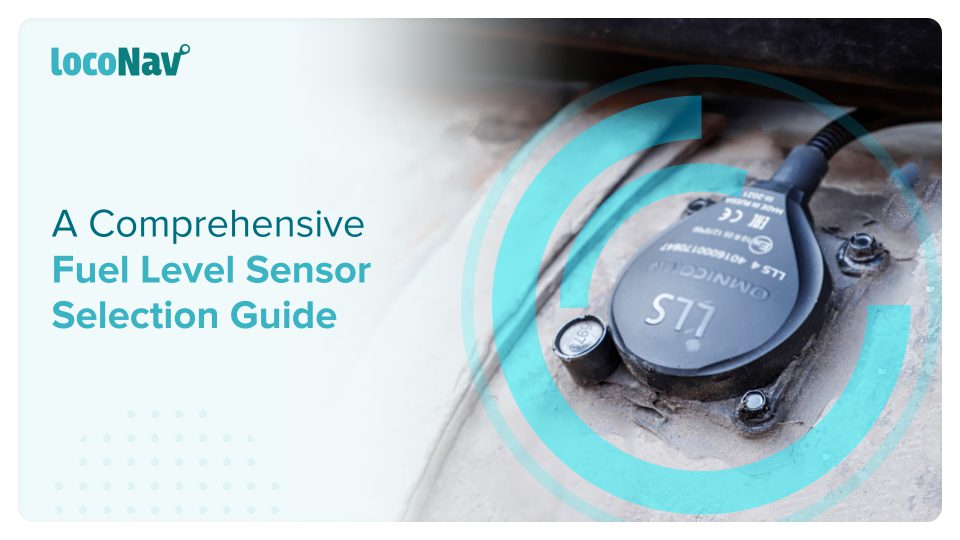

With the fleet industry having such a heavy reliance on its assets, managing fuel-related costs of vehicles that are usually spread across geographies can be quite the challenge. Rising fuel prices are always difficult to deal with. Additionally, challenges like fuel leakage, engine idling, fuel theft, and fuel siphoning are a pain to manage manually.
This is where employing a fuel level sensor comes into play. In this blog, we will highlight what a fuel level sensor is, why you need one for your business and some things you should consider before choosing a fuel level sensor for your fleet business.
What is a Fuel Level Sensor?
Fuel level sensors are devices that supervise the continuous level of fuel usage in vehicles as well as stationary fuel tanks. Fuel level sensors, in conjunction with IoT tracking and monitoring solutions, aid in the extraction of information such as:
- Fuel Tank Level
- Fuel Consumption
- Fuel Refilling, Draining, Theft, Pilferage Events
- Fleet Idling
Fuel level sensors are installed on the fuel tanks of vehicles or machines whose fuel usage is being tracked. They are positioned so that the axis of the sensitive element is as close to the geometric centre of the tank as possible. The sensor is then corrected based on tank size. When the setup is finished and linked to the monitoring system, the data is transferred to the software’s platform.
Manage your fleet efficiently with LocoNav’s Fleet Management Solutions!
The platform then analyses the data obtained and sends it to the user in visual form, notifying the fleet manager of changes in fuel level in the tank, which can be visualised from his laptop or mobile device in visual forms.
Why do you Need a Fuel Level Sensor for Your Fleet Business?
Here are some of the key benefits of deploying a fuel level sensor for your fleet business, which will allow you to get the most out of your vehicles:
- Increased Visibility into Fuel Metrics
A fuel level sensor will eliminate the chances of human error by automating your fuel monitoring process. By deploying a fuel level sensor, you will have easy access to real-time data of fuel-related events such as fuel consumption, refilling, and drainage. This information will ultimately help you in making more informed decisions about your fleet’s fuel budgets.
- Reduced Fuel Pilferage and Theft
Fuel theft is a common issue in the fleet industry. With thieves getting creative, fleet managers have to keep up. A fuel level sensor is equipped to alert you in case of any fuel-related fraudulent activity. This reduces the chances of you losing out on money due to fuel theft, siphoning, or pilferage.
- Controlled Fuel Costs
By closely monitoring your fuel consumption, refilling, and drainage activities, you can control and allocate funds for your fuel in a more efficient manner.
- Improved Vehicle Performance
By keeping yourself informed about the correct fuel consumption of your vehicles you can plan their maintenance routines more effectively. Timely maintenance will naturally improve the performance of your vehicles by reducing the chance of unnecessary wear and tear.
5 Things You Should Consider Before Choosing a Fuel Level Sensor
Deploying a fuel level sensor not makes operational sense, but also gives your fleet business a chance to be a success. Keeping that in mind, here are 5 things you should consider before choosing a fuel level sensor for your fleet:
- Define Your Purpose
Define the function of a fuel sensor in your business.
- Why do you need one?
- Define your fuel type.
- Do you want to use fuel sensors in the vehicle’s fuel tank or stationary fuel tank?
- Research Market Offerings
Determine the type of fuel sensors you will employ. There are numerous models on the market, so take into account and identify the various models. Learn more about the different types of fuel monitoring on the market.
- Set A Budget
There are various types of fuel level sensors available in the market and they are priced at various price points. Carefully consider your own budget and the monetary benefit a fuel sensor will give your business.
- Consider Your Fuel Tank Dimensions
When selecting a fuel sensor, tank dimensions (height, width, and shape) are critical. The requirements for installing fuel level sensors differ depending on the type of sensor.
The ultrasonic sensor generally works better with a narrow fuel tank. The capacitive sensor must be marginally higher than the tank height. Capacitive fuel sensors are primarily appropriate for unshaped tanks.
- Aim For Quality
The importance of quality in product selection cannot be overstated. Many manufacturers fail to provide customers with high-quality products.
The product’s quality is well defined throughout the manufacturing process (product design, raw materials, creating a prototype, constructing a finished package, running tests, upkeep, support, company policy, instructions, and customer experience). All of these factors indicate how valuable the product is. Make sure you thoroughly inspect the product.
LocoNav Fuel Monitoring System: Increase the Efficiency of Your Fleet
LocoNav works with the goal of assisting vehicle owners in automating and managing their day-to-day fuel monitoring activities. If your vehicle’s fuel efficiency is ineffective, consider installing a LocoNav fuel monitoring system to prevent tank draining and double-dealing.
There are numerous factors that influence fuel efficiency; gaining knowledge in these areas will aid in real-time fuel efficiency improvement and can reduce fuel costs.
- Up-To-Date Monitoring of Fuel Levels
- Real-Time Fuel Draining Alerts
- Reports on Fuel Efficiency
The reason fleet owners install vehicle tracking systems in their vehicles is to have complete control over their vehicle while it is on the road. They must also reduce fuel waste by implementing a fuel monitoring system.